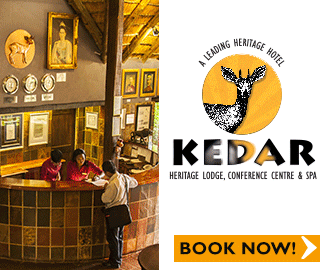
Discover a Village with Altitude
WORDS & PHOTOGRAPHS BY MATHIEU DASNOIS, 9 JULY, 2015 09:50
“We are close. I can smell them”. Agre, my Tanzanian guide in this rainforest, either has an acute sense of smell or an odd sense of humour.
I wonder if the Black and White Colobus monkeys are in heat, but I don't ask. Agre scans each tree. But all I can see are leaves. The monkeys would have to be within a hundred metres, or they might as well be in Rome. Apparently I am not to worry, we will see them today. Agre sounds sure of himself.
We are walking in the Western Usambaras, part of the ancient Eastern Arc chain. The Swiss Alps of Tanzania, the Galapagos of Africa, prized for their cool climate and their extraordinary biodiversity.
The Magamba rainforest is a maze of unmarked paths, making tourism an opportunity for a young man who can speak a little English. In theory, most of the guides like Agre work with community tourism initiatives, feeding the funds back into infrastructure, schools and other projects. In practice, each slags off the others as thieves and private money-makers. Who knows? Tourism is the new cash crop.
We weave quietly from path to path, through ancient ferns and over little streams, around old German dams and down windy paths through patches of sunlight the size of my palm.
Agre has lightened his step, and I follow suit, hunching in a ridiculous attempt to stay hidden. The giant trees, straight as massive arrows, sway from side to side, laughing at my foreign stealth. He beckons me to a window in the leaves. "Look there”.
The Colobus! The gap in the foliage is no bigger than my head and the monkeys are far away, but not far enough. They have seen us and are already scuttling away up a tall tree. Either my vaunted stealth failed or Agre's not the only one with a sense of smell.
He and I part at Irente viewpoint, on the edge of the Usambaras, where the mountains suddenly plummet to the vast Maasai steppe.
Most hikes here start from Lushoto, the regional capital and a great base from which to explore the area. The town lies in a bowl, surrounded by beautiful mist-shrouded peaks etched with winding footpaths where many feet, walking always in single file, have revealed the red earth under the green hills. Cloud clings to the slopes, fighting the wind.
Life here is centered on the market and the bus station, with small restaurants and bars and barber shops and cramped houses and people selling what they can in the street to passing buses or pedestrians. On Sundays, Lushoto comes alive. People from all over the mountains come for the market. The marketplace, where dried and fried fish and beans and lentils and rice and honey are sold, develops a chaotic arm that stretches into the streets around, onto mats and kangas on the ground, around houses, until twisting alleyways are filled to bursting with people trying to pass each other without stepping on the vendors’ wares. Pricelists develop into musical cries. Local fruit and vegetables dominate, with food displayed neatly on kangas of every colour, vendors shielded from the sun by even more colourful umbrellas. Nothing is drab. The market spills, uncontained, over stalls, onto the creek bed, back into the road, wherever a flat patch of red earth can be found.


Lushoto is also the starting point for the five day hike to Mtae, often touted as the best walk in the Usambaras. We opt to go by bus, a spectacular four hour journey along green valleys dotted with villages caked with the red dust thrown up by passing buses. Children, shouting and waving, run at our bus. Adults spread their arms in greeting and welcome. Many villagers come to the road, often the only one in the village, simply to watch the bus go past every day.
Trade springs where villagers sell tiny bunches of fruit. One stall offers a few bananas, three corn cobs, and a handful of dried fish no bigger than my palm. In a world with few private vehicles, the buses bring mail, messages, money and goods. One passenger unloads a small cardboard box, wrapped in twine, contents unknown; two plastic bags; six pineapples, in two bunches, and a bicycle pump.
At Mtae, Rogers Shikuli meets us on the way to our hostel, offering his services as a guide to this small, quiet, and meticulously friendly farming town.
Mtae's altitude makes it an ideal position to acclimatise for Kilimanjaro, which is visible from here on clear days. The village offers the few tourists who make it here breathtaking views from the edge of the Usambaras. For the locals, many of whom must walk down up and down winding paths, to the tomatoes, beans, and maize fields at the foot of the hills, Mtae’s position is a challenge.
But as in much of Tanzania, this burden is borne silently, the villagers carrying big loads on their heads always seemingly smiling and laughing. Only when we ask do we learn that they have been walking all day, as they do every day.
Rogers takes me on what is supposed to be a leisurely stroll but “leisurely” takes on a different meaning in a mountain village.
Agre, my Tanzanian guide in this rainforest, either has an acute sense of smell or an odd sense of humour.
The village offers the few tourists who make it here breathtaking views from the edge of the Usambaras. For the locals, many of whom must walk down up and down winding paths, to the tomatoes, beans, and maize fields at the foot of the hills, Mtae’s position is a challenge.
The village offers the few tourists who make it here breathtaking views from the edge of the Usambaras. For the locals, many of whom must walk down up and down winding paths, to the tomatoes, beans, and maize fields at the foot of the hills, Mtae’s position is a challenge.
But as in much of Tanzania, this burden is borne silently, the villagers carrying big loads on their heads always seemingly smiling and laughing. Only when we ask do we learn that they have been walking all day, as they do every day.
We opt to go by bus, a spectacular four hour journey along green valleys dotted with villages caked with the red dust thrown up by passing buses. Children, shouting and waving, run at our bus. Adults spread their arms in greeting and welcome. Many villagers come to the road, often the only one in the village, simply to watch the bus go past every day.

On the way, we exchange greetings with almost everyone we pass. A sense of community permeates the thin mountain air; this is a place where the elderly are greeted with the utmost respect. “Shikamoo” or literally “I clasp your knees” is answered by “marahaba”, “I acknowledge you”. Many tourists don't know this, so a horde of children skulk around, clasping white knees but forever unacknowledged by the foreigners.
Back in Mtae we are invited into Rogers’ home, where his parents welcome us with great kindness.,
The language barrier is solid, but through Rogers, thank-yous fly back and forth as we sit inside the tiny room where the only furniture is a wooden stool which the father, Alfonso, made. Chickens walk through the house.
They thank us for coming to their home, to Mtae, to the Usambaras. We thank them for their hospitality, their village, their kindness.
Outside, on the white mud wall, alongside the red geometric patterns, is a painted heart inscribed with the word "Karibuni", plural for welcome. Welcome to all.
We are offered plums from their tree. They apologise profusely that they have no more to give. We wring our empty hands, unprepared as we were for this visit. Later, over dinner at Mtae's only restaurant, we give Rogers a belated present, a bottle of honey from Lushoto. His brilliant smile assures us that it will be well-received.
After dinner Rogers takes me to the local bar. It's a small room with benches lining the walls and tables in the centre. All the furniture is wooden, wobbly, almost as old as the patrons who are getting slowly drunk on sugar-cane beer and liquor. I am hailed with great interest when I enter and given a place of honour next to the matron who controls the liquor. At $0.10 cents, US, for a bottle of beer or a glass of strong spirit, a little goes a long, wobbly way. A few patrons try their luck, trying to get a free drink from the foreigner.
I don't have the heart to tell them that, because I only wanted a taste, the white guy got his drink for free.














